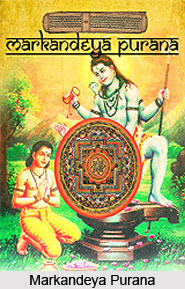 Markendeya Purana is one among the major eighteen Puranas. It is written in the style of a conversation between Sage Jaimini and Sage Markandeya. The work takes its name from the ancient sage Markandeya, who enjoyed eternal youth, and who also appears in a large section of the Mahabharata as a narrator. Different from the other Indian Puranas, this Purana is neutral to Lord Vishnu and Lord Shiva i.e. it has no sectarian content. This is one of the most important, most interesting and probably one of the oldest works of the whole Purana literature.
Markendeya Purana is one among the major eighteen Puranas. It is written in the style of a conversation between Sage Jaimini and Sage Markandeya. The work takes its name from the ancient sage Markandeya, who enjoyed eternal youth, and who also appears in a large section of the Mahabharata as a narrator. Different from the other Indian Puranas, this Purana is neutral to Lord Vishnu and Lord Shiva i.e. it has no sectarian content. This is one of the most important, most interesting and probably one of the oldest works of the whole Purana literature.
Origin of Markandeya Purana
This Purana is no unified work, but consists of parts which vary in value and probably belong to different periods. One may probably regard those sections as the oldest, in which Markandeya is actually the speaker and instructs his pupil Kraustuki upon the creation of the world, the ages of the world, the genealogies and the other subjects peculiar to the Puranas. Special evidence for the great antiquity of these sections which contain the old Purana is found in the circumstance that in them neither Vishnu nor Shiva occupy a prominent position, that, on the other hand, Indra and Lord Brahma are much in the foreground and that the ancient deities of the Veda, Lord Agni (Fire) and Lord Surya (Sun) are glorified by hymns in a few of the cantos, and that a large number of sun-myths are related. This oldest part of the Purana may belong to the third century A.D., but may perhaps be earlier. A large part of this section also consists of moral and edifying narratives.
Chapters of Markandeya Purana
There are one hundred thirty four chapters included in this Purana. Of all these, the chapters starting from fifty and ending to ninety-seven contain the accounts of the fourteen Manvantaras (the periods of the Manus). Among these, chapters 78-90 are together known as Devi Mahatmya or glorification of the great goddess. The chapters 108-133 deal with the genealogies of the Puranic dynasties. Just as in the Mahabharata, so here too, there are besides legends purely didactic dialogues upon the duties of the householder, upon Shraddhs, upon conduct in the daily life, upon the regular sacrifices, feasts and ceremonies, and also (Chapters 36-43) a treatise upon Yoga. A work complete in itself which was only later inserted into the Markandeya Purana, though not later than the 6th century A.D., is the Devimahatmya, a glorification of the goddess Durga. In the temples of this terrible goddess the Devimahatmya is read daily, and at the great feast of Durga (Durga Puja) in West Bengal it is recited with the greatest of solemnity.
Thus discussed is the Markendeya Purana, one of the oldest and most interesting of the ancient Indian Puranas.



















